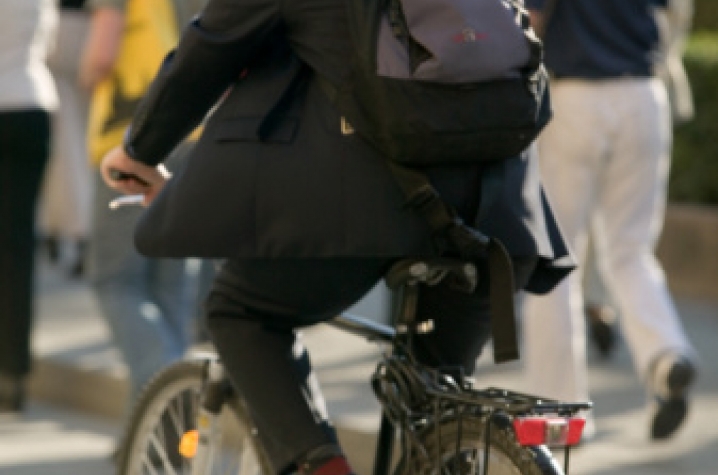Bikers and Pedestrians Travel Common Ground

LEXINGTON, Ky. (Nov. 16, 2011) − One misstep by a pedestrian or a cyclist wheeling too fast can send books and papers flying, not to mention scraped knees or sprained wrists and damaged bikes. The rules of the University of Kentucky’s shared use paths — extra-wide sidewalks crisscrossing central campus that are designated for both cyclist and pedestrian travel — often get misconstrued, resulting in close calls and in some cases injurious collisions.
According to Parking & Transportation Services’ Vehicle, Parking and Permit Regulations, bicyclists “must obey the rules of the road. At all times and at any location on campus, pedestrians have the right-of-way. Careless or reckless operation of any bicycle on University property is prohibited.” In addition, not all campus sidewalks are designated as shared use, and should be avoided by bike riders.
In an effort to increase physical activity and environmental stewardship as a community, UK encourages its students, faculty, staff and visitors to ride their bikes to campus. In recent years several miles of city streets have been re-designed to accommodate bike lanes, making it safer to arrive at campus from considerable distances. More are planned for the near future. A few years ago, cyclists were required to park their bikes at racks located on the outskirts of campus and then to walk the rest of the way to class. Now, the shared-use sidewalks allow bikers to pedal nearly to the doorstep of their destination. Plans call for an additional 1.6 miles of shared sidewalks on campus, but it is unlikely that many of the narrower sidewalks, some with steps along the route, will ever be designated a shared path.
Sharing the sidewalk demands an understanding of all travelers. “The intent behind the shared sidewalk markings was to create a more positive atmosphere for cyclists on campus,” said Shane Tedder, UK sustainability coordinator. “The shared use emblems have been placed on sidewalks wide enough to accommodate cyclists and pedestrians and also indicate that cyclists should always yield to pedestrians.”
Bicyclists are subject to citation and/or impoundment at the owner’s expense if they commit one the following PTS violations. For more information, visit http://www.uky.edu/pts/parking-info_parking-regulations.
a. Failure to yield the right-of-way to a pedestrian.
b. Operating a bicycle in a careless manner without due regard for the safety of persons and protection of property.
c. Operating a bicycle on University property posted for no bicycles.
d. Operating a bicycle on a pedestrian-only walkway.
e. Operating a bicycle on unpaved surfaces.
f. Operating a bicycle in a building, elevated pedestrian walkway (pedway), or stairway.
g. Operating a bicycle at unsafe speeds.
h. Operating a bicycle in the opposite direction of traffic flow.
Bikers sometimes travel well above a reasonable speed on heavily populated sidewalks and near buildings with heavy foot traffic. Some bikers come up from behind a pedestrian so silently and pass so quickly that an absent-minded step in the wrong direction could end badly for both.
“The recently reorganized Bike Advisory Committee is developing a set of programs focused on the goal of reducing conflicts between pedestrians and cyclists,” Tedder said. “When riding on sidewalks, cyclists should always yield to pedestrians, dismount when necessary, and use a bell or other audible warning to let pedestrians know that they are coming.”
Pedestrians also have responsibilities to ensure their own safety and that of others. “Pedestrians should always check for cyclists before stepping into bike lanes when attempting to cross an intersection,” Tedder said.
According to the UK Police Department, 14 biker and pedestrian accidents have been recorded since 2009. “While bikes on the sidewalk can be difficult to enforce, the education is out there,” said UK Police Captain Thomas Matlock. “We have officers that go to dorms and offer programs for both biker and pedestrian safety.”
Biker and pedestrian safety can be enhanced. “It is a constant battle on campus. Police officers can stop bicyclists, but they are not in the habit of stopping pedestrians,” Matlock said. “It would be great if everyone could take time and learn the rules of travel. This way, both parties could put themselves in the others' shoes and come to a common understanding.”
Lessons of communication can carry outside the classroom and onto the pathways around campus. “The most important communication issue is for cyclists riding on sidewalks to let pedestrians know they are there and to pass in a safe manner at a reasonable speed,” Tedder said.
The shared sidewalks are expanding, and so is the importance of learning the rules of the road. “We would like to see an additional 2 miles of dedicated bike facilities added to our existing network of 7.7 miles,” Tedder said. “We want to develop programs that promote safe and predictable cycling behavior and to offer commuter cycling classes for beginners.”
If you plan on walking, running or riding to class the best thing you can do is to learn the rules and protocols for how you are to travel to ensure the most safety. In addition, realize the people around you are on the same mission. “Understand the other person and their objectives,” Matlock said. “Treat them the way you would like to be treated.”
For more information on the sustainability plan on UK’s campus, visit http://www.sustainability.uky.edu/transportationresources.




